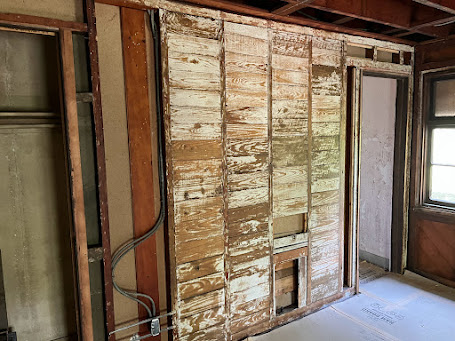But one day our carpenter, Robb Geores, came by, and Scott Sillars and I passed a couple fascinating hours with him scrutinizing the newly exposed guts of the house. Many a clue was found that may shed light on the house's multiple lives.
We were upstairs in the study when Robb announced, "I found some more writing!" He was scrutinizing a single stack of those slats running along the edge of the chimney.
There, you see it? Neither did we, but a really close look reveals that one of the slats is larger than the others.
And on it is some writing, revealing that it had once been the top of a packing crate, with the shadow of a stamp on the upper right.
The crate was addressed to J.P.W. Stuart in Bedford, NY. That would be Jesse Paulmier Whiton-Stuart. He and his wife Mary moved the house from Morristown to Princeton, and lived in it for ten years before selling it to the Veblens. Bedford was and is an upscale town that had not come up previously in our research of the itinerant Whiton-Stuarts, who had lived in Manhattan, Greenwich, CT, Prescott, AZ, Morristown, and allegedly in Tuxedo Park, before moving to Princeton. Can we conclude that he was well-known in Bedford, if a package could find him without a street address? (Note: Evelyne Ryan of the Bedford Historical Society wrote me that "it wasn’t until the implementation of 911 that many Bedford addresses had numbers – roads, yes, but not numbers." That would have been the late 1960s)

The return address on the crate's top left is 543 Madison Ave, New York City. We couldn't make out the name, though, until I showed it to Clifford Zink. "Demarest," he said without pause. He also pointed out the tiny "&" symbol after Demarest. "Demarest & Cook?", I ventured, before later settling on "Demarest & Co."
Demarest proved to be J.C. Demarest, later fleshed out to James Cleveland Demarest, president and treasurer of an interior decorating firm. His ads appeared in these 1925-26 issues of Arts and Decorations, alongside articles about anything from bathroom adornments to the latest in literature, music, and art. A sophisticated critique of Carl Sandburg's biography of Lincoln rubbed shoulders with Demarest's conception for a well appointed dining room.


This Nov, 1925 issue had lots for the wealthy to contemplate, admire, and buy. Articles come in quick succession, with "The Hard Brilliance of Earnest Hemmingway" (also Conrad Aiken, Sherwood Anderson) on p. 57, followed by some American triumphalism about skyscrapers in "The New Architecture of a Flamboyant Civilization", "Painted Doors are the Final Distinction for the Handsome Room", and "Great Modern Hotels of America." The magazine captures the world the Whiton-Stuarts seem to have inhabited, at least until the crash of 1929. Beginning around 1900, Whiton-Stuart owned a prosperous real estate company that specialized in high-end properties on Madison Ave. in Manhattan. Society pages tracked the Whiton-Stuart's visits to elite locales and later the seven or so marriages of their
son and
daughter.
Jesse grew up on Park Avenue, and collected photographs later compiled in a book entitled "
Views and Maps of Old New York."
Another article in Arts and Decorations featured the home of prominent architect Grosvenor Atterbury, who in 1909 designed sophisticated prefab homes for Forest Hills in Queens. According to wikipedia, "each house was built from approximately 170 standardized precast concrete panels, fabricated off-site and assembled by crane." Whiton-Stuart would have been up on the latest trends in architecture--an engagement that may have led to his experimenting with the prefab construction now fully on display at Veblen House.
Also found in the Arts and Decorations magazine was a full page color ad for Johns-Manville's asbestos shingles. Yes, hard to believe now, but asbestos was big in the 1920s, and the 30s and 40s, on up to the 1970s. The Johns-Manville company supplied some of the materials for Veblen House, as will be explored in another post.
The March, 1926 issue has an article singing the praises of
gumwood for paneling. Gumwood? Turns out they're talking about sweetgum, a native tree of which there are many in Herrontown Woods. I lived in a house in Michigan that had beautiful sweetgum paneling, but have not seen it anywhere since. There's no "gumwood" in Veblen House, but it does have two rooms creatively and expertly paneled with plywood parquet--a material that caught the eye and interest of an architectural historian at the NJ Historic Trust. That, too, is material for another post.
You can see how finding the words "Demarest & Co" on a wall in Veblen House has set off a whole google-powered adventure into the life and times of the Whiton-Stuarts, but why would Whiton-Stuart, or his carpenter, have embedded that particular piece of a packing crate in one of the walls? Robb raised the possibility that the carpenter was simply using whatever wood was on hand. But every other slat nailed to the walls is generic and uniform in size.
J.C. Demarest died in 1932. One story handed down about Veblen House is that a cabinet maker worked for two years customizing the interior. If the house went up in 1931, that would mean that Demarest died while the house was being worked on. The piece of packing crate was placed next to a hearth, upside down. A hearth represents importance. Might upside down have some symbolism for loss? More about any connection and friendship between Demarest and Whiton-Stuart may ultimately be found in the detailed accounts on society pages back then of who was seen where with whom.













Nice Post
ReplyDelete